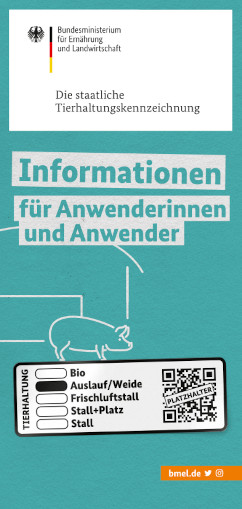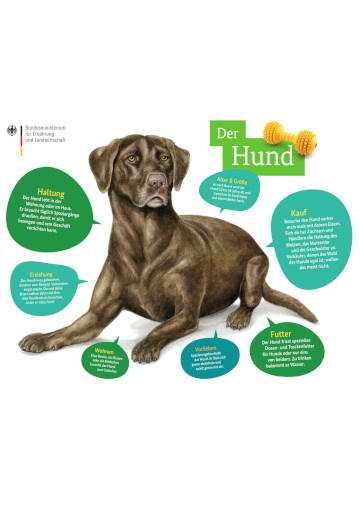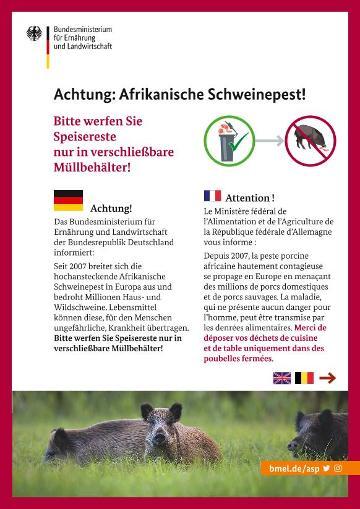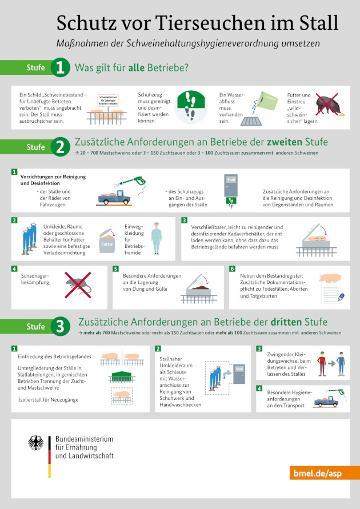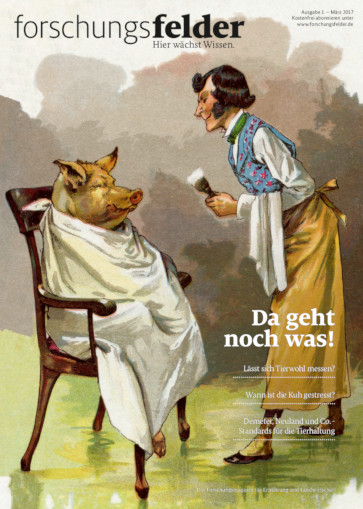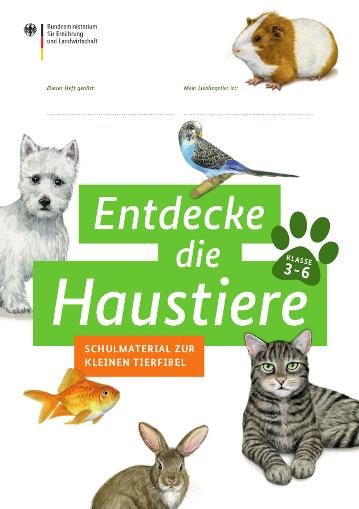Hygienic quality of water for drinking
Indicative framework for an assessment with regard to animal feed law
This document presents the legal bases for water for drinking for animals, discusses criteria for quality assessment, gives recommendations for sampling, and provides benchmark data for specific parameters.
1. Introduction
Besides the provision of energy and essential nutrients, the provision of sufficient quantities of water (2 to 5 litres per kg of dry matter intake, depending on the species, type of use, performance level, feeding, weather conditions and other factors) of appropriate quality is an essential prerequisite for the health and performance of farmed animals. The sole responsibility for this rests with the animal keeper. Water can therefore be regarded as the most significant nutrient or as the most important feedingstuff.
Among other things, water is essential for maintaining the internal cell pressure (cell turgor), for digestive processes, nutrient transport, urine composition (excretion of substances which must be eliminated through urine) and thermoregulation of the animals. If the quantity of water provided is insufficient, the animals will, for example, take in less feed and hence their performance will be lower, they will be more susceptible to diseases and less active. Undesirable substances might also be transferred from the water for drinking to food of animal origin.
The aim of this indicative framework for assessing the hygienic quality of water for drinking with regard to animal feed law is to compile and describe the essential requirements regarding the hygienic quality of water for drinking. With this at hand, the animal keeper can attend to his duties with regard to feed hygiene more reliably.
The indicative framework, commissioned by the Federal Ministry of Food, Agriculture and Consumer Protection, was drawn up by R. Böhm, G. Flachowsky, J. Kamphues, M. Lahrssen-Wiederholt, U. Meyer and H. Schenkel and was coordinated with the feed inspection authorities of the Länder (Federal States) and the agricultural organisations and trade associations concerned. Details can be found in the publication on "Empfehlungen zur futtermittelrechtlichen Beurteilung der hygienischen Qualität von Tränkwasser" (Recommendations on assessing the hygienic quality of water for drinking with with regard to animal feed law) (Kamphues et al. 2007).
2. Regulatory framework
Regulation (EC) No. 178/2002 of the European Parliament and of the Council of 28 January 2002 (the so-called Basic Regulation) lays down the framework conditions for ensuring food and feed safety. The Basic Regulation defines "feed" or "feedingstuff" as any substance or product, including additives, whether processed, partially processed or unprocessed, intended to be used for oral feeding to animals. Under EC law, water for drinking is therefore covered by the term "feed" or "feedingstuff". This definition has also been used in the new German Food and Feed Code of 1 September 2005.
To support the protection goals laid down in the Basic Regulation, a regulatory framework laying down feed hygiene requirements was established under Regulation (EC) No. 183/2005 of the European Parliament and of the Council of 12 January 2005 (Feed Hygiene Regulation).
The Feed Hygiene Regulation, which has been applicable since 01.01.2006, establishes, among other things, specific requirements farmers or animal keepers must meet when feeding food-producing animals. The corresponding provisions can be found in the section on "Feed and water" in Annex III ("Good animal feeding practice") of the Feed Hygiene Regulation. According to this, the water for drinking shall be "of appropriate quality" for the animals being produced. Furthermore,
watering equipment must be designed, constructed and placed in such a way that contamination … of water is minimised. Watering systems shall be cleaned and maintained regularly, where possible.
The authors do not consider it appropriate to transfer the requirements laid down in the German Drinking Water Ordinance (TWVO of 21 May 2001 on the quality of water intended for human consumption) to water for drinking. This view is based inter alia on the significance of on-farm water supplies for livestock farming and on the fact that exceeding the limit values of the Drinking Water Ordinance does not generally have negative impacts on animals or the food produced from them and that some criteria have only been established for technical reasons.
3. Quality of water for drinking
Whilst drinking water for human consumption must meet the requirements of the Drinking Water Ordinance, there are currently no comparable detailed legal requirements regarding water for drinking for animals. The existing legal provisions (e.g. Basic Regulation, Feed Hygiene Regulation, Food and Feed Code) only contain general safety requirements. The appropriate quality of water for drinking required by the Feed Hygiene Regulation (Annex III) could be characterised by the requirements in Table 1.
| Table 1: Characterisation of water for drinking "of appropriate quality" for food-producing animals | |
| Requirements1) | Explanation / significance |
| Palatability | prerequisite for sufficient water intake (= prerequisite for an adequate intake of dry matter) |
| Tolerance | ingredients and/or undesirable substances only in a concentration which is not harmful or detrimental to the animals or the food produced from them |
| Usability | no adverse effects on the building fabric (e.g. building and watering technology) and when using2) the water for the preparation of feed |
a 1) in general, this also implies a corresponding sensory quality (e.g. turbidity, strange smell) b 2) e. g. also when applying medicines, certain feed additives, etc. | |
In accordance with Table 1, water of appropriate quality should not only be palatable and well-tolerated but must also fulfil requirements related to its use in animal husbandry which ensure the animals’ water supply (e.g. risk of blockage in the watering system due to high levels of calcium or iron).
3.1. Biological quality
In literature, there are different parameter recommendations regarding the biological quality of water for drinking.
Water fed into the system should be free of salmonella and campylobacter (in 100 ml) and, if possible, largely free of E.coli (in 10 ml); the total aerobic microbial count should not exceed 1,000 CFU/ml at 37°C and 10,000 CFU/ml at 20°C. If germs are repeatedly detected in this concentration, it can be assumed that there is an increased contamination level in the system or the water fed into it. If these parameters are not met, animal keepers should identify the causes (e.g. dust in the livestock building, feed leftovers, animal excreta or intrusion of wastewater) and take appropriate constructional, technical or organisational measures to bring the biological quality of the water for drinking to a suitable standard.
3.2. Chemical and physico-chemical quality
Different parameters can be used to assess the chemical and physico-chemical quality of water for drinking, such as pH value, conductivity, salt content and concentration of inorganic and organic ingredients.
Tables 2 and 3 provide recommendations for benchmark data for assessing the physico-chemical and chemical quality of drinking water, paying due regard to food and feed safety and the specifications provided by other authors.
When deriving these benchmark data it was, among other things, assumed that less than 10 per cent of the maximum permissible quantities of each substance which the EU has established for feeding purposes should originate from the water for drinking (approx. 3 l water intake per kg of feed dry matter). If the values resulting from this approach were lower than the limit values for drinking water for human consumption, the corresponding drinking water value was taken. Additional comments and footnotes provide further explanations on the proposed benchmark data. According to currently available data, there is no need to provide benchmark data for other elements.
4. General remarks on sampling
Before taking a sample, the purpose for which this is done should be clear, as the sampling site and the parameters to be investigated should be chosen in accordance with this purpose. Routine samples should be taken, if possible, at the place where the water is fed into the system. When verifying abnormalities or clarifying animal diseases, samples should also be taken at the drinker.
Sampling details should be coordinated with the testing laboratory.
5. Recommendations
The provision of sufficient quantities of the feedingstuff "water" of appropriate quality is an essential prerequisite for the health and performance of food-producing animals and for the prevention of any transfer of organisms and/or substances into the food chain. The following is recommended:
- Animals should have permanent access to water for drinking.
- The water requirement per kg of dry matter intake varies between 2 and 5 l among the different species and animal categories, depending on several influencing factors (e.g. temperature).
- According to Annex III of the Feed Hygiene Regulation, the water for drinking shall be "of appropriate quality" for the animals being produced. Criteria for the appropriate quality of the water for drinking comprise palatability, tolerance and usability (inorganic and organic ingredients and contaminants).
- The appropriate quality of the water for drinking should primarily be tested at the level of the water fed into the system or the water already within the system, in particular with regard to germ content and chemical quality.
- The water for drinking for the animals should still be of appropriate quality at the time when the animals actually consume it. This must be ensured by an appropriate design and mounting and by regular cleaning and maintenance of the watering devices.
- When supplying food-producing animals with water for drinking which does not come from the public system, it is recommended that the water quality should be tested at regular intervals. Initial information about the status of regional water bodies can be obtained from institutions such as environmental authorities, health boards, working groups of the Federal States (e.g. water quality maps).
- When testing and assessing the quality of water for drinking, other legal framework conditions must also be taken into account, e.g. the Zoonoses Directive when detecting certain pathogens, or the feed law provisions on undesirable substances (e.g. Annex 5 of the Animal Feed Ordinance).
- If the water for drinking is treated using a physical process or by adding organisms or substances, only approved processes or products may be used (substances approved for use in drinking water or as feed additives or biocides). The respective conditions and restrictions of use must be observed.
| Table 2: Recommendations for benchmark data for assessing the physico-chemical quality of water for drinking (water for drinking fed into the system and water already within the distribution system) in terms of feed and food safety | ||||
| Parameter | Unit | Benchmark for the appropriate quality of water for drinking for animals | Comments (possible problems) | Limit value for drinking water for human consumption in accordance with the Drinking Water Ordinance |
| pH value5) | > 5 < 9 | Corrosion in the pipe system | 6.5 to 9.5 | |
| Electrical conductivity | µS/cm | < 3000 | Possibly diarrhoea if values are higher, palatability | 2500 |
| Soluble salts, in total | (g/l) | < 2.5 | ||
| Oxidisability6) | (mg/l) | < 15 | Indicates the level of oxidisable substances | |
| Table 3: Recommendations for benchmark data in mg/l for assessing the chemical quality of water for drinking (water for drinking fed into the system and water already within the distribution system) in terms of feed and food safety | |||
| Parameter | Benchmark for the appropriate quality of water for drinking for animals | Comments (possible problems) | Limit value for drinking water for human consumption in accordance with the Drinking Water Ordinance |
| Ammonium (NH4+) | < 3 | Indication of contamination | 0.5 |
| Arsenic (As) | < 0.05 | Health disorders, poorer performance | 0.01 |
| Lead (Pb) | < 0.1 | 0.01 | |
| Cadmium (Cd) | < 0.02 | 0.005 | |
| Calcium (Ca)7) | 500 | Functional disorders, calcification of pipes and valves | No limit value available |
| Chloride (Cl-) | < 2501) < 5002) | Moist excreta1) | 250 |
| Iron (Fe)7) | < 3 | Antagonist of other trace elements, iron deposits in pipes, biofilm formation, impact on taste | 0.2 |
| Fluorine (F) | < 1.5 | Teeth and bone disorders | 1,5 |
| Potassium (K) | < 2501) < 5002) | Moist excreta1) | No limit value available |
| Copper (Cu)8) | < 2 | Pay attention to the total intake in sheep and calves | 2 |
| Manganese (Mn) | < 4 | Sedimentation in the distribution system, possible formation of biofilms | 0.05 |
| Sodium (Na) | < 2501) < 5002) | Moist excreta1) | 200 |
| Nitrate (NO3-) | < 3003) < 2004) | Risk of methaemoglobin formation, pay attention to the total intake | 50 |
| Nitrite (NO2-) | < 30 | Risk of methaemoglobin formation, pay attention to the total intake | 0.5 |
| Mercury (Hg) | < 0.003 | General disorders | 0.001 |
| Sulfate (SO42-) | < 500 | Laxative effect | 240 |
| Zinc (Zn)9) | < 5 | No limit value available | |
1 1) poultry 2 2) other species 3 3) ruminating ruminants 4 4) calves and other species 5 5) pH < 5: acidic, possibly having a corrosive effect, adding organic acids can lower the pH. 6 6) measurement of organic substances in water (< 5 mg/l for water fed into the system) 7 7) clogging of pipes and nipple drinkers 8 8) this benchmark is problematic for sheep and for calves fed with milk replacer (use low-Cu milk replacers) 9 9) benchmark only for the preparation of milk replacer | |||


